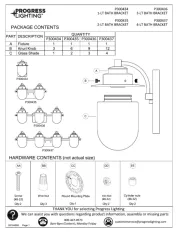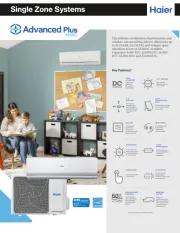EMOS B9684 Bedienungsanleitung
EMOS
Nicht kategorisiert
B9684
Lies die bedienungsanleitung für EMOS B9684 (24 Seiten) kostenlos online; sie gehört zur Kategorie Nicht kategorisiert. Dieses Handbuch wurde von 3 Personen als hilfreich bewertet und erhielt im Schnitt 3.5 Sterne aus 2 Bewertungen. Hast du eine Frage zu EMOS B9684 oder möchtest du andere Nutzer dieses Produkts befragen? Stelle eine Frage
Seite 1/24

1201003700_31-B9684_00_01 148 × 210 mm
www.emos.eu
GB Operation Manual
CZ Návod k použití
SK Návod na použitie
PL Instrukcja użytkowania
HU Üzemeltetési kézikönyv
SI Navodila za uporabo
RS|HR|BA|ME Uputa za uporabu
DE Bedienungsanleitung
RO Instrucţiuni de utilizare
LV Lietošanas instrukcija
EE Kasutusjuhend
BG Ръководство за експлоатация
zdroj: 1201000100_31-B9641_00_01.indd

2
GB | Operation Manual
Maintenance free standby (stationary) accumulator type AGM
(VRLA design, lead battery with soaked in electrolyte – valve
controlled, suitable for ALARMS, UPS standby supply, emergency
lighting, telecommunications etc.)
This manual describes commissioning of individual battery–accumu-
lator types, their maintenance, safe handling, storage and disposal.
Important warning:
• Each battery (cell, accumulator) is a chemical source of electric
power; it contains solid or liquid chemicals (caustics) which
may cause harm to human health, damage to property or the
environment. Therefore it is necessary to handle the battery
with special care.
• Accumulator, as a power source, is, in ready state, able to sup-
ply electric power at any moment, not excluding unintended
circumstances! Caution, even partially charged batteries, when
both their contacts (terminals) become interconnected by a
conductive material (e.g. during negligent handling, transport,
storage etc.), uncontrolled release of large volume of electric
power occurs, it is called SHORT CIRCUIT. In the better case only
the battery is damaged. In worse case, providing the contact is
lasting longer (afew seconds is enough), it can cause re, and
yet explosion, damage to property or environment, last but not
least, though, harm to human health or even death! Therefore
it is recommended to always handle batteries so as to prevent
the short circuit!
• Used batteries and the old unused ones, functional and non
functional batteries and cells become hazardous waste upon
exploitation, and as such can, if disposed improperly, present a
serious risk to environment! Absolute majority of batteries contain
dangerous chemical elements and compounds. Lead, cadmium,
mercury, electrolyte (HSO), and other, poisonous agents harmful
to human heath. These may be released as a result of improper
disposal and cause nature contamination. That is why we beg you
not to dispose used batteries and cells as municipal waste! We will
recollect any exploited batteries and cells from you FOR FREE, and
we will ensure their proper and safe liquidation and recycling. Ac-
cording to Act on Waste each municipality is obligated to provide,
so called, collection spots, where citizens can deposit hazardous
part of municipal waste. Used batteries and cells are also always
collected at the point of their sale.
• Individual accumulators vary greatly from one another. When
replacing a new battery for a used one, it is always necessary to
observe instructions of the device manufacturer (standby source
– UPS etc.), which stipulates which accumulator is designed for
particular devices. Installation of unt battery type may cause
irreversible damage of the device. In such case warranty claim
cannot be accepted from the side of battery supplier nor from
the device manufacturer.
a) Description
Gases are released from standby battery VRLA (Valve Regulated Lead
Acid) through a valve. Practically it means that nearly no aerosols
leak out from electrolyte H . The valve blocks gas leaks and it can SO
handle overpressure of up to 0.43 kPa. The battery is designed on the
basis of lead and electrolyte bound to berglass microbers (so called
AGM – absorbed glass mat) or, exceptionally, to gel (contain electrolyte
thickened by tixotrophic gel – SiO ). AGM type standby batteries are
common for devices of UPS type (standby supplies), EPS (electronic re
signalization), EZS (electronic security systems), emergency lighting,
telecommunication applications, but also as source for actuation for
electrical motors (scooters, toys, and a number of other appliances).
b) Maintenance, storage and handling
Stationary AGM type batteries are maintenance free. However, basic
rules have to be observed during their use, in order to prevent short-
ening of their service life. Operation conditions are very important,
especially ambient temperature. Optimum operation temperature
suggested by manufacturer is 20°C to 25°C. In case of permanent
or temporary excess of these thresholds, service life of the batteries
dramatically drops. In case of extremely high operation temperatures,
irreversible damage can occur. Prolong exposure of the battery to op-
eration temperatures exceeding 40°C, at which all chemical processes
are faster, high gas production occurs, resulting in building of internal
overpressure within the cell. Under such circumstances the valves are
no longer able to regulate the overpressure and the accumulated
gasses cannot escape, which results in volume increase (it literally
inates). Service life of AGM batteries claimed by manufacturers, on
condition the optimum operation conditions are met, is between 4 to
12 years, depending on a particular model. The AMG technology very
eciently suppresses the self discharge eect. While classic ooded
batteries loose to self discharge approximately 1 % of capacity a
day, with AGM type the loss is dramatically lower. The loss is about
13% per month (i.e. max. 0.1% a day)! That naturally extends the
storage time. Operation and handling of standby batteries requires
only observance of basic rules. The batteries can be operated in any
position. The bottom up position is the least suitable and it is not
recommended, though. Battery must not be stored or operated near
open re. Fall from height or heavy impacts may cause irreversible
mechanical damage. During storage, handling and operation the
contacts must not be connected to each other, it would represent
a short circuit hazard. That can result in battery damage, re, health
or life hazard, or to battery explosion. In case of mechanical damage
of the battery housing the electrolyte may escape (caustic), and/or
skin contact may occur. In case of skin contact immediately rinse the
aected area with clean water and neutralize the electrolyte with soap
or soda. In case of more extensive contact or in case of cauterization
seek medical help as soon as possible.
c) Charging
Prior to charging process make sure what nominal voltage is your
battery. Then check if your charger is suitable for charging of given
type of accumulator (AGM, GEL) and if it can supply suitable nominal
voltage. Last but not least, check if the charger is powerful enough
for charging of your accumulator or if it is not too powerful, as that
would make it also unsuitable, for it would charge the battery with
too strong current.
Charging is nothing complicated, let us tell you how to do it. If you
are not sure you fully understand our instructions, seek advice of an
expert, or have an expert do the charging. You may also resort to
manual provided with the charger.
Some sections of chapter c) describe situations that are unneces-
sary information for users of automatic chargers. These sections are
marked with asterisk (*).
• Accumulator type – Charging of maintenance free accumulator
type AGM or GEL will be described.
• Correct voltage – Make sure that your charger is set to correct
nominal voltage for 12 V or 6 V batteries, some chargers have no
switch, so it is enough to just check if data on both the compo-
nents match (e.g. 12 V charger and also 12 V battery).
• Correct polarity – Prior to activating the charger check the order
of poles on the battery and terminal clamps on the charger cables,
then connect correctly plus to plus and minus to minus, if not
observed – short circuit hazard occurs.
• Ventilation – Check that venting (valve gaps) is not dirty or
blinded and that the gases may freely escape the battery as
necessary, venting = valve gaps in the battery cover (on top or on
its side), in case these are obstructed, gasses accumulate inside
which can result in irreversible damage. Some batteries do not
have gaps or these are covered.
• Setting of automatic charger – In case the charger can be set
for more options, follow the instructions in the charger manual.
Charging voltage and current are usually set. The following
paragraph gives instructions for charging current values. If the
charger does not have any setting elements, start it by insert-
ing the plug of the power cord to the wall socket 220 V (230 V),

3
the cables with clamp terminals should be connected to the
poles of battery by now.
• Charging current* – General rule says, charge by current of one
tenth value (1/10) of the battery capacity. Formulated in numbers,
if you have a 60 Ah accumulator, charge it at 6 A (60:10 = 6 A). There
is a more precise charging formula, it says: the charging current
should equal 0.12 multiple of the accumulator capacity. In other
words: ”I = 0.12 × C“. Technically you are to charge a 60 Ah battery
as follows: 60×0.12 = charging current is 7.2 A.
Majority of users today use automatic chargers, in such case just
choose suitable charger with sucient current, with respect to the
fact that the charging time is directly proportioned to the value of
charging current, and charging time may be too long (for 60 Ah
current of 1 A is too low). And on the other hand do not choose
a too strong charger in order to prevent too fast charging which
is also, in long term prospective, damaging the accumulator (e.g.
for 60 Ah current of 14 A is too strong).
Note: If you are charging by adjustable charging current, charge ac-
cording to formula: “I = 0.12 C” up to voltage of 14.2 V, then lower ×
the current by half and continue until the battery is fully charged
(voltage reaches14.4 V).
• Signs of fully charged battery* – In general, the battery is
charged until signs of full charge have been reached. For main-
tenance free batteries without plugs, or for AGM with soaked in
electrolyte the thickness cannot be measured any more, do not,
under any circumstances, try to penetrate the battery! For the
12 V maintenance free lead batteries types AGM or GEL charged
in standard manner by manual charger the charging status may
be judged by measuring the voltage between the poles during
charging. The values may be interpreted as follows: 14.3 V = 90to
95% charged, 14.4 to 14.5 V = 100% charged.
CAUTION – Observe the correctly set values on the meter – volt-
age [V].
• Rapid charging* – In case of need for rapid charge it is possible to
use charging current of I = 1 × C (in our case, for 60 Ah batteries the
charging current will be 60 A). However, charge with this current
for no longer than 30 minutes! Keep in mind, that the more often
you use higher current for charging your battery, the shorter ser-
vice life may be expected for the given accumulator in the future.
• Accumulator capacity – Current capacity (charge status) may
be roughly dened by metering instruments. Either instruments
for approximate measuring may be used without loading the ac-
cumulator, or also more precise instruments measuring internal
resistance can be used. However, the remaining service life of
an accumulator can only be precisely dened through complex
diagnostic process, using an expensive testing instrument that
operates on the principles of charging and discharging. Such
diagnostics may take several hours for small batteries and up
to several days for larger batteries. Any battery capacity testing
is always recommended for fully charged accumulators with
a delay of at least 4 hours after charging. Rough capacity test
may be done by a simple electrical gauge – voltmeter. Measure
without load, i.e. voltage without use of current only. Compare
the measured values with the following table (note: for old, longer
used or damaged batteries the test results may be distorted or
completely useless, such batteries may only be judged and tested
by the more complex methods):
Charge status Voltage measured
100% 12.90+ V
75% 12.60 V
50% 12.40 V
25% 12.10 V
0% 11.90 V
• Deep discharge – If an accumulator is fully discharged and left
for a few days, so called, deep discharge state occurs, measured
voltage without load drops bellow 11 V level, and a process
called sulfation is triggered inside the cells. The sulfur, originally
contained in the electrolyte, “soaks” to active masses of the lead
plates due to discharge. Charging than causes repeated “pushing”
and mixing the sulfur back to watery electrolyte, i.e. increasing of
the acid saturation. In the other case, though, it reacts with lead,
further oxidizing occurs, active lead surfaces change their chemi-
cal composition to lead sulphate, briey sulphate. This process is,
in advanced stage, irreversible and the accumulator is irreversibly
damaged. If the accumulator gets to the deep discharge state, it
often cannot be charged by a regular automatic charger. These
chargers tend A) not to be able to detect voltage of deeply dis-
charged battery and the charging process does not start, or B)
to start charging, but are not capable of overcoming the internal
resistance of the sulfated accumulator and they tend to overheat.
To bring the accumulator back to life, try to give the battery to
specialized service. Deep discharged batteries and batteries with
such damage are not covered by warranty.
• Maintenance of maintenance free accumulator – The basic rule
in maintenance of lead batteries says: keep the battery, if possible,
constantly in charged state. If it needs to be discharged – used
(logically), charge it immediately after discharging it.
d) Introducing the battery to operation
For battery introduction to operation always adhere to device
manufacturer’s instructions. Observe the safety instructions. In case
of doubt seek expert advice.
CZ | Návod k použití
Bezúdržbový záložní (staniční) akumulátor typ AGM (konstrukce
VRLA, olověná baterie se zasáknutým elektrolytem – řízená venti-
lem, vhodná pro ALARMY, UPS záložní zdroje, nouzové osvětlení,
telekomunikace, atd.)
Tento návod popisuje uvedení jednotlivých druhů baterií – akumu-
látorů do provozu, jejich údržbu, bezpečnou manipulaci, skladování
a likvidaci.
Důležitá upozornění:
• Každá baterie (článek, akumulátor) je chemický zdroj elektrické
energie, obsahuje tuhé či tekuté chemické sloučeniny (žíraviny),
které mohou způsobit újmu na zdraví, majetku či životním pro-
středí. S bateriemi proto manipulujte se zvýšenou opatrností.
• Akumulátor, jakožto zdroj elektrické energie, je v připraveném
stavu schopný kdykoliv dodávat elektrický proud, a to i za nežá-
doucích okolností! Pozor i u částečně nabité baterie, při vzájem-
ném propojení obou kontaktů (terminálů) vodivým materiálem
(např. při neopatrné manipulaci, při přepravě, skladování, apod.)
dojde k nekontrolovanému uvolnění velkého množství elektrické
energie, k takzvanému ZKRATU. V lepším případě dojde pouze
k poškození baterie. V horším případě, je-li jev dlouhodobý (stačí
však i několik vteřin), může způsobit požár, dokonce výbuch, újmu
na majetku či životním prostředí, ale v neposlední řadě také újmu
na zdraví či životě člověka! S bateriemi proto vždy zacházejte tak,
aby ke zkratu nedošlo!
• Použité baterie i staré nepoužité, funkční i nefunkční baterie a
články se po spotřebování automaticky stávají nebezpečným
odpadem, který může při neodborné likvidaci vážně ohrozit
životní prostředí! V naprosté většině obsahují baterie nebez-
pečné chemické prvky nebo jejich sloučeniny. Olovo, kadmium,
rtuť, elektrolyt (H ), ale i další, lidskému organismu škodlivé, SO
jedovaté látky. Ty se mohou vlivem špatného uložení uvolňovat
do přírody a zamořit ji. Proto Vás prosíme, neodkládejte spotře-
bované baterie a články mezi komunální odpad! ZDARMA od Vás
jakékoliv použité akumulátory i články odebereme, a zajistíme
jejich řádnou a bezpečnou recyklaci či likvidaci. Podle zákona o
odpadech, má každá obec povinnost zajistit tzv. sběrná místa, kam
mohou její obyvatelé odkládat nebezpečné složky komunálního
Produktspezifikationen
| Marke: | EMOS |
| Kategorie: | Nicht kategorisiert |
| Modell: | B9684 |
Brauchst du Hilfe?
Wenn Sie Hilfe mit EMOS B9684 benötigen, stellen Sie unten eine Frage und andere Benutzer werden Ihnen antworten
Bedienungsanleitung Nicht kategorisiert EMOS
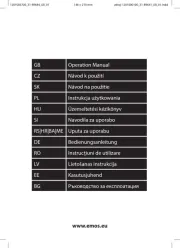
14 Juli 2025
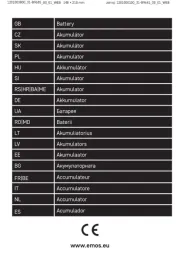
14 Juli 2025
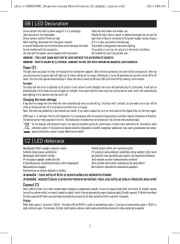
14 Juli 2025
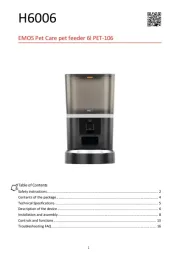
6 Juli 2025
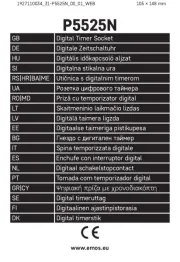
5 Juli 2025
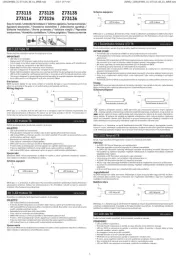
16 Juni 2025
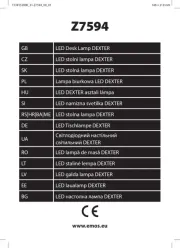
16 Juni 2025

16 Juni 2025

15 Juni 2025
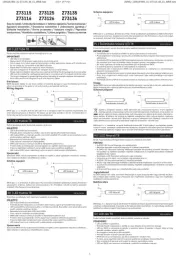
15 Juni 2025
Bedienungsanleitung Nicht kategorisiert
- Topeak
- Calex
- Honor
- Creative
- Squarp Instruments
- Watts
- Narva
- Soul
- Savic
- Absco
- IXS
- Plasma Cloud
- Weihrauch Sport
- Cooper Lighting
- go-eCharger
Neueste Bedienungsanleitung für -Kategorien-

15 Juli 2025
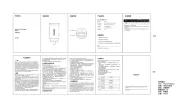
15 Juli 2025
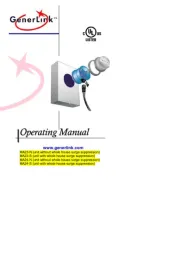
15 Juli 2025

15 Juli 2025
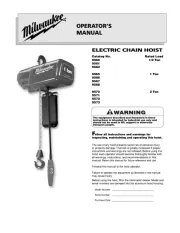
15 Juli 2025

15 Juli 2025

15 Juli 2025
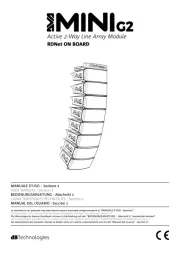
15 Juli 2025
